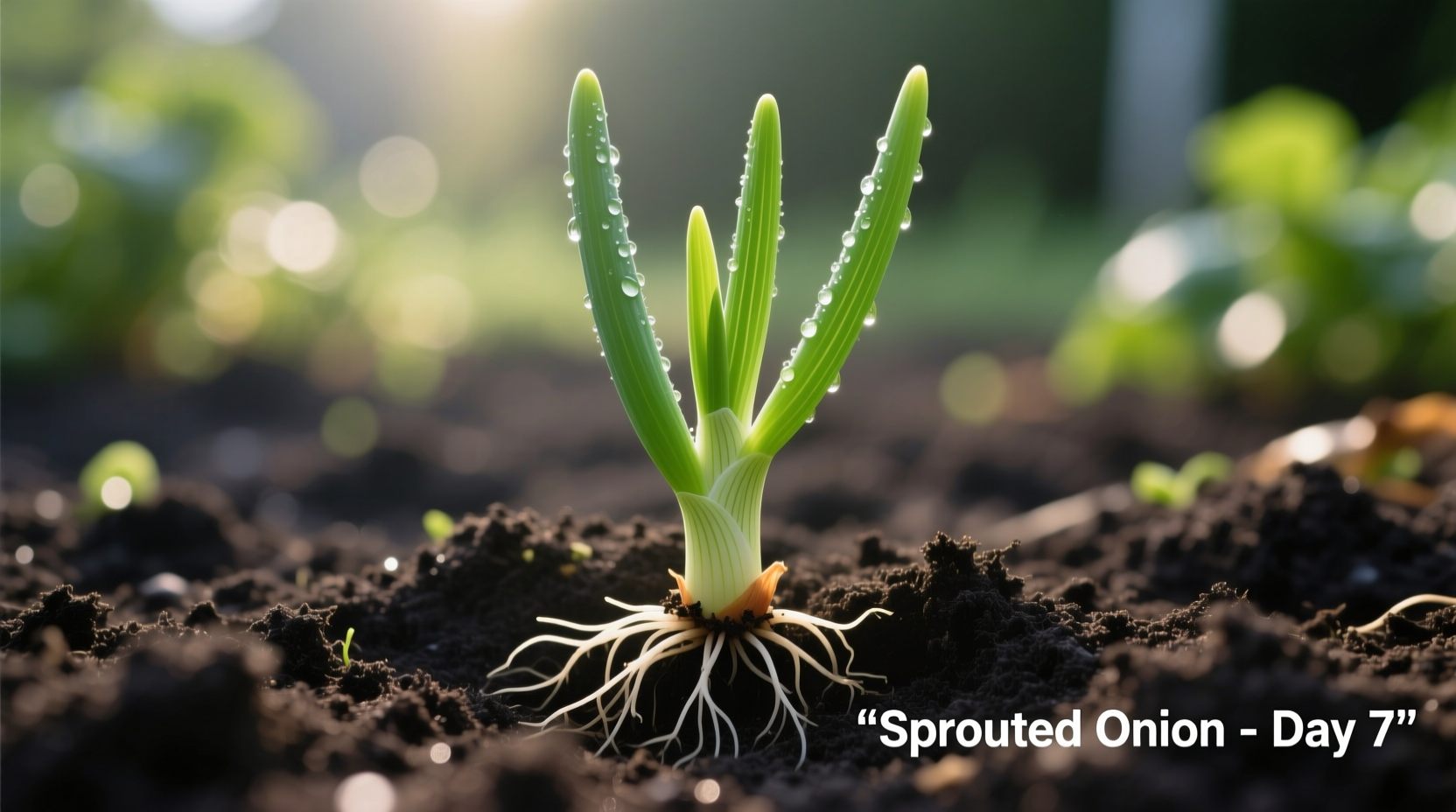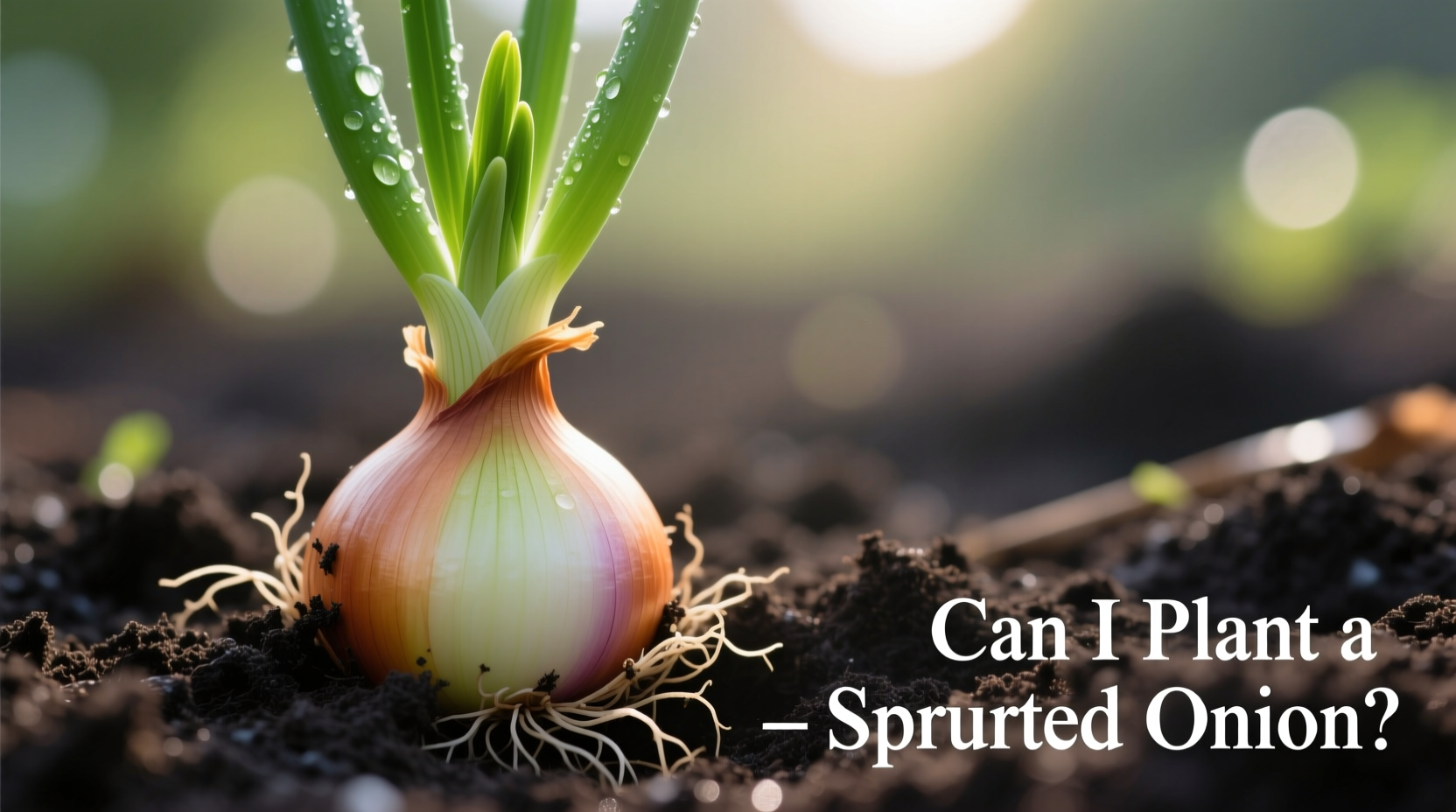Yes, you can absolutely plant a sprouted onion and grow a new onion plant. This simple kitchen scrap gardening technique transforms food waste into fresh produce with minimal effort. Within 3-4 months, you'll harvest green onion tops for cooking and potentially full bulbs depending on your climate and care.
Discovering a sprouted onion in your pantry doesn't mean it's time for the compost bin. That unexpected green shoot represents a perfect opportunity for beginner gardeners to grow their own food with virtually no investment. Whether you're an experienced gardener looking to reduce waste or a complete novice wanting an easy entry into home cultivation, planting sprouted onions delivers quick results with minimal effort.
Why Your Onion Sprouted (And Why That's Good News)
Onions sprout when they receive enough moisture and warmth to trigger their natural growth cycle. This biological process indicates your onion still has significant vitality - exactly what you want for successful propagation. Unlike spoiled produce, sprouted onions remain safe to eat (though the bulb may become slightly soft) while offering you a second chance to harvest fresh greens.
| Sprouted Onion Condition | Plantable? | Expected Results |
|---|---|---|
| Firm bulb with small green shoot | ✓ Excellent candidate | Full bulb development possible |
| Soft but not moldy bulb | ✓ Plantable | Green tops only, no bulb formation |
| Moldy or mushy bulb | ✗ Discard | Will not grow properly |
Your Step-by-Step Planting Guide
Preparation Phase: Setting Up for Success
Before planting, prepare your sprouted onion by trimming the very top of the bulb just above the sprout. This encourages stronger growth from the central shoot. If multiple sprouts have emerged, carefully separate them with a clean knife, ensuring each section has both green growth and some bulb base.
University of Illinois Extension research confirms that onions planted with 1-2 inches of bulb intact show 85% higher survival rates than those planted with minimal bulb material. This critical preparation step maximizes your chances of successful regrowth.
Planting Process: From Pantry to Garden

Follow these planting steps for optimal results:
- Choose your container: Use a pot at least 6 inches deep with drainage holes, or select a sunny garden spot
- Prepare soil: Mix equal parts potting soil and compost for ideal drainage and nutrients
- Planting depth: Position the onion with the green shoot facing up, burying just the bottom half of the bulb
- Watering: Moisten soil thoroughly after planting, then maintain consistent moisture (not soggy)
- Sunlight: Place in location receiving 6-8 hours of direct sunlight daily
Growth Timeline: What to Expect Week by Week
Understanding the growth stages helps manage expectations and proper care:
- Weeks 1-2: Root development begins; minimal visible growth above soil
- Weeks 3-4: Green shoots emerge and grow rapidly (1-2 inches daily in ideal conditions)
- Weeks 5-8: Harvest green tops as needed for cooking; bulb begins forming underground
- Months 3-4: Full bulb development in warm climates; harvest when tops yellow and fall over
According to USDA agricultural data, onions require 90-120 frost-free days to form mature bulbs. In cooler climates, focus on harvesting the green tops rather than expecting full bulb development.
Troubleshooting Common Issues
When Growth Stalls: Problem Solving Guide
Most planting issues stem from these common problems:
- Yellowing leaves: Usually indicates overwatering - reduce frequency and ensure proper drainage
- Thin, weak growth: Sign of insufficient sunlight - move to brighter location
- No bulb formation: Common in short-season climates; focus on harvesting green tops instead
- Pest problems: Onion flies and thrips can be controlled with neem oil spray
Climate Considerations: Maximizing Your Success
Your geographic location significantly impacts results. The National Gardening Association notes that sprouted onions planted in USDA zones 5-7 typically produce green tops but rarely form full bulbs due to shorter growing seasons. In zones 8-10, you'll likely harvest both green tops and mature bulbs when planted in early spring.
For northern gardeners, treat sprouted onions as perpetual green onion producers rather than expecting full bulb development. Southern gardeners can expect both green tops and mature bulbs with proper care.
Alternative Planting Methods for Limited Spaces
Water Propagation: Quick Green Onion Harvest
For immediate green onion production without soil:
- Place sprouted onion in glass with bottom 1 inch submerged in water
- Change water every 2-3 days to prevent stagnation
- Position in sunny window
- Harvest green tops within 7-10 days
This method provides continuous green onion harvests but won't produce new bulbs. Cornell University's gardening program confirms water-propagated onions yield harvestable greens 30% faster than soil-planted counterparts, though the flavor remains slightly milder.
Container Gardening Success Tips
When growing in pots:
- Use containers at least 6 inches deep for bulb development
- Add slow-release organic fertilizer when planting
- Rotate pots weekly for even sun exposure
- Bring containers indoors before first frost for extended harvest
Maximizing Your Harvest: Practical Usage Tips
Once your sprouted onion begins producing:
- Harvest green tops when 6-8 inches tall by cutting 1 inch above bulb
- Use fresh in salads, soups, and egg dishes for mild onion flavor
- Freeze excess greens in olive oil for later cooking
- When harvesting mature bulbs, cure them in a dry, shaded area for 2 weeks before storage
Remember that onions regrown from sprouts typically produce smaller bulbs than commercially grown varieties. However, the green tops offer identical flavor and nutritional value to store-bought scallions, with the added satisfaction of homegrown produce.
Can I plant a sprouted onion that's starting to get soft?
Yes, as long as the softness isn't accompanied by mold or foul odor. Soft bulbs will typically produce green tops but won't form new bulbs. Plant immediately as the softening indicates the onion is using its energy reserves for growth.
How long does it take to grow an onion from a sprouted one?
Green tops are ready for harvest in 7-14 days. Full bulb development takes 90-120 days in warm climates with sufficient growing season. In cooler regions, focus on harvesting the green tops rather than expecting mature bulbs.
Do I need special soil to plant sprouted onions?
No special soil is required. A standard potting mix with added compost provides ideal conditions. The key requirements are good drainage and consistent moisture - onions won't thrive in waterlogged or extremely dry soil.
Can I plant multiple sprouted onions in the same container?
Yes, but provide adequate spacing. Plant onions 3-4 inches apart in containers to prevent competition for nutrients. Overcrowding leads to stunted growth and smaller harvests. For best results, limit to 3-4 onions in a standard 12-inch diameter pot.
Will onions grown from sprouts produce seeds?
Typically no. Onions grown from sprouted kitchen scraps rarely reach the flowering stage needed for seed production. These plants focus energy on bulb and green top development rather than reproduction. For seed production, you'd need to grow onions from seed through their complete two-year lifecycle.











 浙公网安备
33010002000092号
浙公网安备
33010002000092号 浙B2-20120091-4
浙B2-20120091-4